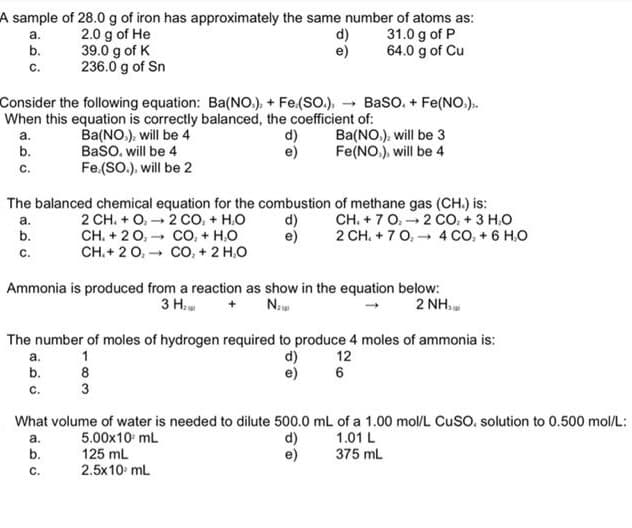Chemistry: Principles and Reactions
8th Edition
ISBN:9781305079373
Author:William L. Masterton, Cecile N. Hurley
Publisher:William L. Masterton, Cecile N. Hurley
Chapter3: Mass Relations In Chemistry; Stoichiometry
Section: Chapter Questions
Problem 1QAP: One chocolate chip used in making chocolate chip cookies has a mass of 0.324 g. (a) How many...
Related questions
Question
Please give clear handwritten answer of all subparts

Transcribed Image Text:A sample of 28.0 g of iron has approximately the same number of atoms as:
31.0 g of P
64.0 g of Cu
2.0 g of He
39.0 g of K
236.0 g of Sn
d)
e)
а.
b.
c.
Consider the following equation: Ba(NO.). + Fe.(SO.), BasO. + Fe(NO.).
When this equation is correctly balanced, the coefficient of:
Ba(NO.), will be 4
Baso. will be 4
Fe.(SO.), will be 2
d)
e)
Ba(NO.), will be 3
Fe(NO.), will be 4
а.
b.
с.
The balanced chemical equation for the combustion of methane gas (CH.) is:
CH. + 7 0. 2 Co. + 3 H.O
2 CH. + 7 0, 4 CO, + 6 H.O
2 CH. + O. - 2 cO. + H.O
CH. + 2 0, - CO, + H.O
CH.+ 2 0, - CO, + 2 H,O
d)
e)
a.
b.
C.
Ammonia is produced from a reaction as show in the equation below:
2 NH.
3 H..
N.
The number of moles of hydrogen required to produce 4 moles of ammonia is:
a.
1
d)
12
b.
8
3
6
e)
с.
What volume of water is needed to dilute 500.0 mL of a 1.00 mol/L CuSO. solution to 0.500 mol/L:
5.00x10 mL
125 mL
d)
a.
1.01 L
b.
e)
375 mL
2.5x10 mL
С.
Expert Solution
This question has been solved!
Explore an expertly crafted, step-by-step solution for a thorough understanding of key concepts.
Step by step
Solved in 4 steps

Knowledge Booster
Learn more about
Need a deep-dive on the concept behind this application? Look no further. Learn more about this topic, chemistry and related others by exploring similar questions and additional content below.Recommended textbooks for you

Chemistry: Principles and Reactions
Chemistry
ISBN:
9781305079373
Author:
William L. Masterton, Cecile N. Hurley
Publisher:
Cengage Learning


Chemistry
Chemistry
ISBN:
9781305957404
Author:
Steven S. Zumdahl, Susan A. Zumdahl, Donald J. DeCoste
Publisher:
Cengage Learning

Chemistry: Principles and Reactions
Chemistry
ISBN:
9781305079373
Author:
William L. Masterton, Cecile N. Hurley
Publisher:
Cengage Learning


Chemistry
Chemistry
ISBN:
9781305957404
Author:
Steven S. Zumdahl, Susan A. Zumdahl, Donald J. DeCoste
Publisher:
Cengage Learning

Chemistry: An Atoms First Approach
Chemistry
ISBN:
9781305079243
Author:
Steven S. Zumdahl, Susan A. Zumdahl
Publisher:
Cengage Learning

Chemistry: Matter and Change
Chemistry
ISBN:
9780078746376
Author:
Dinah Zike, Laurel Dingrando, Nicholas Hainen, Cheryl Wistrom
Publisher:
Glencoe/McGraw-Hill School Pub Co

General Chemistry - Standalone book (MindTap Cour…
Chemistry
ISBN:
9781305580343
Author:
Steven D. Gammon, Ebbing, Darrell Ebbing, Steven D., Darrell; Gammon, Darrell Ebbing; Steven D. Gammon, Darrell D.; Gammon, Ebbing; Steven D. Gammon; Darrell
Publisher:
Cengage Learning